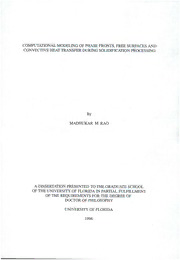
Computational modeling of phase fronts free surfaces and convective heat transfer during solidification processing PDF
Preview Computational modeling of phase fronts free surfaces and convective heat transfer during solidification processing
COMPUTATIONALMODELINGOFPHASEFRONTS,FREESURFACESAND CONVECTIVEHEATTRANSFERDURINGSOLIDIFICATIONPROCESSING By MADHUKAR M.RAO ADISSERTATIONPRESENTEDTOTHEGRADUATESCHOOL OFTHEUNIVERSITYOFFLORIDAINPARTIALFULFILLMENT OFTHEREQUIREMENTSFORTHEDEGREEOF DOCTOROFPHILOSOPHY UNIVERSITYOFFLORIDA 1996 ACKNOWLEDGEMENTS IcanonlytrytoexpressmyheartfeltthankstoProf. Shyyforhisguidanceand friendshipthroughoutthecourseofmygraduatestudy.Withouthishelpandpatientguidance thisworkwouldnothavebeenpossible.Hishardworkandpersistencehavebeenagreat sourceofinspirationtome. Ithanktheothermembersofmycommittee,Dr.Fearn,Dr.Kurzweg,Dr.Lindgrenand Dr.Goswamifortheirguidanceandhelpduringthecourseofthiswork. IthankDr.-Ing.T.K.BoseofIIT-Madrasforinitiatingmeintothescienceandartof computationalaerodynamicsandMr.S.C.RajanofIIT-Madrasforhismemorablelectures thatattractedmetofluiddynamics. TomycolleaguesandfellowresearchersintheCFDgroup,Dr.Siddarth"ST"Thakur, Dr.JeffWright,Dr.RickSmith,Dr.H.S.Udaykumar,Dr.EdwinBlosch,Jian"James"Liu, VenkatKrishnamurthyandHongOuyang,Iexpressmyheartfeltthanksforthememorable timesandthemanyusefuldiscussionsandcollaborativeworkthatwehavesharedduring thecourseofourgraduatestudy. Someofthecomputationscarriedoutinthisworkweresupportedbyagrantof computertimefromtheresearchcomputinginitiative,NERDC,UniversityofFloridaand weredoneontheirIBMSP2cluster.PartialfinancialsupportfromGEandAFOSRURIare gratefullyacknowledged. Specialthanksareduetomywife,Vijayasri,forherencouragementandsupportthat greatlyassistedmystudiesinthelasttwoyears.Mysister,Madhuri,hasbeenaconstantand livelysourceofencouragementandsupportwhichhasmademylifeallthericher.Iowea specialdebtofgratitudetomyparentswhichcanneverbefullyrepaid.Withouttheirefforts andtheemphasisthattheyplacedonagoodeducation,Iwouldneverhaveamountedto anything.Tothem,Idedicatethisthesis. ii TABLEOFCONTENTS page ACKNOWLEDGEMENTS ii TABLEOFCONTENTS iii ABSTRACT vi CHAPTERS INTRODUCTION 1 1 1.1 Motivation 1 1.2 ComputationalMethodology 2 1.3 FloatZoneCrystalGrowth 4 2 FORMULATIONFORCONVECTIVEHEATTRANSFER ANDFREESURFACEFORMATION 9 2.1 Background 9 2.2 SourcesofConvection 10 2.2.1 NaturalConvection 10 2.2.2MarangoniConvection 11 2.3 Nondimensionalization and ScalingProcedure 12 2.3.1 HeatConductionScales 12 2.3.2NaturalConvectionScales 12 2.3.3TheMarangoniNumber 13 2.3.4MarangoniConvectionScales 13 2.4 GoverningEquationsandSolutionProcedure 14 2.5 FormulationandMethodologyforFreeSurfaceComputation 16 2.6 ResultsandDiscussion 21 2.6.1LowBondNumber 21 2.6.2HighBondNumber 28 2.6.3DeterminationofPressurizationValues 29 2.6.4SolutionsforAspectRatioofUnity 31 iii 2.7 ConcludingRemarks 33 3 CONVECTIVE HEAT TRANSFERCOMPUTATIONS 35 3.1 Background 35 3.2 ConvectionTreatmentandAccuracyAssessment 35 3.2.1 ResultsandDiscussion 39 3.3 TransientNaturalConvectioninanEnclosure 42 3.3.1 FormulationandSolutionProcedure 49 3.3.2ResultsandDiscussion 52 3.4 SteadyThermocapillaryConvectioninaLiquidBridge 63 3.4.1 Scaling,NondimensionalizationandGoverningEquations 64 3.4.2HeatTransferCalculations 67 3.4.3NumericalProcedure 67 3.4.4HeatConduction 69 3.4.5NaturalConvection 69 3.4.6InteractionofNaturalandThermocapillaryConvection 70 3.5 EffectofConvectiononMeniscusShape 77 3.6 ConcludingRemarks 80 4 ENTHALPYBASEDPHASECHANGEMODELING 81 4.1 Background 81 4.2 HeatConduction 82 4.3 NumericalImplementation 85 4.3.1 TheT-BasedMethod 85 4.3.2TheH-BasedMethod 87 4.4 ResultsandDiscussion 87 4.4.1 AccuracyAssessment 87 4.4.2PerformanceAssessment 89 4.4.3Summary 90 4.5 ConvectiveEffects 95 4.5.1 GoverningEquations 95 4.5.2SourceTermsintheMomentumEquations 96 4.5.3SourcesofConvection 97 4.5.4ComputationalProcedure 98 4.6 EffectofGravityJitter 99 4.7 FloatZoneGrowthofNiAl 101 4.7.1 CalculationProcedure 104 4.7.2ResultsandDiscussion 107 iv 4.7.3HeatConduction 108 4.7.4ThermocapillaryConvection 108 4.8 ConcludingRemarks 112 5 MOVINGBOUNDARYCOMPUTATIONOFFREESURFACEFLOW ANDSOLIDIFICATIONINFLOATZONEPROCESSING 115 5.1 Introduction 115 5.2 GoverningEquationsandBoundaryConditions 115 5.2.2.1 ThermalBoundaryConditions 117 5.2.2.2 FreeSurfaceTreatment 117 5.2.2.3 Symmetry 118 5.3 MovingGridTransformation 120 5.4 ComputationalMethodology 122 5.4.2.1 ConvergenceCriteria 128 5.4.2.2 GlobalMassConservation 128 5.4.2.3 RootFindingProcedure 129 5.4.2.4 RemeshingProcedure 129 5.5 ResultsandDiscussion 131 5.5.3.1 EstimationofMeniscusShapeandPl 133 5.5.3.2 Conduction-CapillaritySolution 135 5.6 GridRefinementStudyandAssessment 137 5.7 ThermocapillaryConvection 149 5.7.1.1 Cylindricalmeniscus 150 5.7.1.2 Deformedmeniscus 151 5.7.1.4 Cylindricalmeniscus 154 5.7.1.5 Deformedmeniscus 156 5.8 Conclusion 159 6 CONCLUSION 164 6.1 SummaryandConclusions 164 6.2 FutureWork 166 6.2.1 NodeJumping 166 6.2.2Multi-BlockApproach 167 6.2.3Feed/CrystalRotation 167 6.2.4DopantTransport 167 6.2.5ElectromagneticHeating 167 REFERENCES 169 BIOGRAPHICALSKETCH 177 V AbstractofDissertationPresentedtotheGraduateSchool oftheUniversityofFloridainPartialFulfillmentofthe RequirementsfortheDegreeofDoctorofPhilosophy COMPUTATIONALMODELINGOFPHASEFRONTS,FREESURFACESAND CONVECTIVEHEATTRANSFERDURINGSOLIDIFICATIONPROCESSING By MadhukarM.Rao May1996 Chairperson:Dr.WeiShyy MajorDepartment:AerospaceEngineering,MechanicsandEngineeringScience Amethodologyhasbeendevelopedtosimulatefluidflow,heattransfer,freesurface, andphasechangedynamicsinthecontextofsolidificationprocessing.Specialattentionhas beengiventofloatzoneprocessingofsinglecrystalsduetoitsincreasingtechnological importance in growing high quality single crystals and due to the complex physical phenomenainvolved-freesurfaceflow,thermocapillaryandbuoyancydrivenconvection, phasechangeandthenonlinearcouplingamongstthesephysicalphenomena.TheSIMPLE algorithminbodyfittedcoordinateshasbeenchosenforfluidflowandheattransfer computations.Issuesofaccuracyandimplementationofconvectionschemeshavebeen addressedinthecontextofbuoyancydrivenconvection. Accuratesimulationsoftransient naturalconvectionaroundanenclosedverticalchannelhavebeenconductedsinceitisan importantheattransfermechanisminsolidificationaswellasahostofotherapplications suchaselectronicscooling.Theissuesofexistence,multiplicityandnon-uniquenessoffloat zonemeniscihavebeendealtwithinthecontextofafreeenergyminimizationprinciple. vi Steady,thermocapillaryconvectionhasbeensimulatedinaliquidbridgewhichyieldsuseful informationonheattransfercharacteristicsinafloatzoneconfiguration.Bothsinglephase flows and flows with phase change have been computed in this study. Alternative formulations ofenthalpy porosity models have been developed and assessed forthe computationofphasechangedynamicsinthepresenceofmeltconvection.Thesemethods have been applied to compute and assess the impact of interacting natural and thermocapillaryconvectiononsolid-liquidinterfacesduringfloatzonegrowth. Amoving boundaryalgorithmhasbeendevelopedtosimulatethenonlinearcouplingbetweenthe unknownshapeandlocationofthefreesurface,theunknownshapeandlocationofthe solid-liquidinterfaces,andtheconvectiveheattransferprocessesinthefloatzone.This computationalmodelhasalsobeenappliedtoassesstheimpactofboth,normalgravityas wellasmicrogravityconditions,onthedynamicswithinthefloatzone.Ithasbeenfoundthat whereas buoyancy induced convection is negligible under microgravity conditions, significantlevelsofthermocapillaryconvectionexistandhaveaprofoundimpactonthe solid-liquidinterfacemorphologyatthemacroscopicscales.Ithasalsobeenfoundthat undernormalgravityconditions,thecounteractingeffectofnaturalandthermocapillary convectioncanactuallyresultinreducedconvectionstrengthinthelowerhalfofthezone andleadtoaflattersolid-liquidinterfaceshape.Thecalculationproceduresdevelopedin thisstudyconstituteapredictivecapabilityforfloatzonesinglecrystalgrowth. vii CHAPTER 1 INTRODUCTION 1.1 Motivation Thegoalofthisresearchistodevelopandemploycomputationaltoolstomodelphase changeandconvectiveheattransferinmaterialsprocessingapplications.Specialemphasis isplacedonproblemsdealingwithsolidificationandcrystalgrowth.Typicalapplications includegrowthofopticalandsemiconductorcrystalsfromthemeltaswellasintermetallics forhightemperaturestructuralapplications.Solidificationphenomenaoccurringduring materialsprocessingaredominatedbyconvectiveheatandmasstransportinthemelt,and moreimportantly,arecharacterizedbythepresenceofoneormoremovinginterfaces constitutingmovingboundaries.Theseinterfacesarediscontinuitiesseparatingdifferent flowregions;theymaybephasechangeinterfacessuchasthosebetweenthemeltandthe solidortheymaybefreesurfacesseparatingthemeltandtheambientliquidorgas.The nonlinearcouplingbetweenthesedifferentphenomenaisthemajorsourceofmodelingand computationaldifficulties. Modelingoffluidflowandheattransferisamatterofparticularinterestinthisstudy. Thesetransportprocessescontrolthequalityofthegrowncrystalorsolidifiedproduct (Brown 1988,Huppert 1990,Davis 1990).Forexample,highthermalgradientsinthe growingcrystalcanleadtolargethermoelasticstressesthatcancausecrackingorfracture (Viskanta 1990). Solute rejection at the growing interface can lead toconstitutional undercoolinggivingrisetomorphologicalinstabilitiesoftheinterface(MullinsandSekerka 1964,Glicksmanetal.1986). l 2 1.2 ComputationalMethodology Fluidconvectioncanariseinsolidificationsystemsduetoavarietyoffactors.Density differencesinthemeltcausedbythermalandcompositionalinhomogeneitiesgiveriseto buoyancyinducedconvection(Langlois1985).Marangoniconvectionarisesoutofshear stressinducedbythermalandcompositiongradientsalongfreesurfaces.Densitydifferences betweenthemeltandthesolidcanalsobeanimportantsourceofconvectiondependingon thegrowthconfiguration.Inaddition,forcedconvectioncanbepresentduetocrystaland/or cruciblerotationwhichisusuallydoneinordertoevenoutazimuthalinhomogeneitiesin themelttemperatureandcomposition(Langlois1985,Hurle1993). In this work, attention is focused on thermally induced buoyancy driven and thermocapillaryconvection,both,withandwithoutthepresenceofphasechange.Whereas amajorinterestisinproblemsdealingwithcrystalgrowth,naturalandthermocapillary convectionwithoutphasechangehavebeenconsideredasanaturalstartingpointtodevelop and assemble the necessary computational capabilities. The SIMPLE algorithm for incompressibleflowcomputation(Patankar1980)extendedtotreatcomplexgeometryby usingabodyfittedcoordinatesystem(Shyy1994)ischosenastheunderlyingcomputational technique.Itisarobustandprovenmethod,andthesequentialsolutiontechniquebuiltinto themethodenablesadditionalphysicstobeincorporatedwithouttheneedforsubstantial modificationtothealgorithm.Thus,thecomputationaltechniquecanbeextendedinstages thatincludemorecomplexphysicalphenomenawhichincreasesthelevelofconfidencein thecomputationaltechnique. Asastartingpointandtodevelopthenecessarynumericaltechniques,problems involvingnaturalandthermocapillaryconvection,butwithoutphasechange,havebeen investigated.TheSIMPLEalgorithmhasbeenimplementedandtestedagainstanavailable benchmarksolutionfornaturalconvectionofairinasquarecavity.Inchapter3,thisproblem isalsousedtocharacterizetherelativeaccuracyofvariousconvectionschemessuchasthe secondordercentral differencescheme,thesecondorderupwindschemeetc. forthe 3 momentumandenergyequations.Thecomputationaltechniquehasalsobeenextendedto handletheunsteadytermsintheNavier-Stokesequations.Thecomputationaltechniqueis thenappliedtomodeltransientnaturalconvectionandheattransferinaconfigurationused forelectronics cooling. Chapter 3 also describes the extension ofthe computational proceduretosimulatesteadythermocapillaryconvectioninaliquidbridgeofmoltenNiAl -anintermetallicthatisbeingconsideredforhightemperaturestructuralapplicationin futuregenerationofaircraftenginesandotheraerospaceapplications.Themodelisbased onafloatzoneconfigurationcurrentlyinuseforgrowingsinglecrystalsofNiAl. Inchapter4,thecomputationaltechniqueisfurtherextendedtomodelphasechangeand solidificationprocesses.Theenthalpymethod(Crank1984,Shyy1994,Shyyet.al.1995) isparticularlysuitableformodelingphasechangeprocessesatmacroscopicscalesandis chosenforconductingthesolidificationsimulations.Theadvantageoftheenthalpymethod isthatitisafixedgridtechniquewhichobviatestheneedforamovinggridandexplicit interface tracking. However, the volume averaging procedure that is implicit in this techniquesmearsouttheinterfaceinformationoverathinmushyzoneimplyingthat curvature dependent phenomena and interface microstructure cannot be captured. A one-dimensionalheatconductionproblem(Stefanproblem)ischosenasthetestbedto developaparticularlyefficientimplementationoftheenthalpymethodandtocharacterize itsaccuracyandperformance.Theenthalpymethodisalsoappliedtoatwodimensional melting problem dominated by naturalconvection heattransfer andhighly nonlinear interfacial dynamics. Qualitative agreement of the computed interface shapes with experimentaldataisestablished. Theenthalpymethodisthenappliedtosimulatepracticalcrystalgrowthconfigurations. Thefloatzonemodelconsideredinchapter3isextended,inchapter4,totakeintoaccount thenonlinearcouplingofinteractingnatural andthermocapillaryconvectionwiththe melt/crystalandmelt/feedinterfaces.However,thefreesurfaceisheldstationaryinthis
